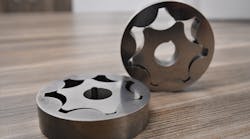Manufacturers who produce generated rotor positive-displacement pump (gerotor) components need process precision. They also need consistency. High-quality surface finishes must be achieved and exacting size tolerances held from the tenth to the ten thousandth part produced.
Such stringent requirements are needed because a pump’s performance and reliability depend on it. A pump’s inner rotor includes a specific number of teeth and rotates inside an outer rotor with one more tooth than the inner rotor. The distance between their two surfaces must be exact. If it’s too close, the components will bind, causing pump failure. Conversely, if the distance is too great, the pump’s efficiency will falter.
Gerotor pumps are used in applications that range from hydraulic motors to automotive oil, gas and power steering. Part material is often either powdered metal or steel forgings, depending on pump application, and finished dimension tolerances are typically as tight as 0.0002 in. The parts also require extremely fine surface finishes.
Grinding is integral to the production of gerotor components, in particular the inner gear (stator) and the external gear (rotor), as well as the housing and other subassemblies. To simplify complete gerotor component production and obtain optimal results, manufacturers rely on specific grinding platforms, including ID, creep feed, cylindrical and tool grinding. In production, these machines will run continuously, pumping out gerotor components every 15 sec., further emphasizing the critical need for process stability and precision along with performance consistency.
With grinding, every produced part is identical throughout the life of the grinding wheel and the next wheels as well. Quality and tolerance are easily maintained when gerotors are ground, and the process improves process capability while boosting process consistency.
The Production Process
In production, typically about six parts are loaded onto a shaft/arbor, which is then mounted to the indexer and tailstock/steadyrest within the machine work envelope. The setup can accommodate multiple arbors as well. This allows shops to set up arbors with parts outside the machine while it continues to work uninterrupted.
At between 50 and 60 ipm, this is an extremely fast creep feed process, as opposed to normal speeds of 4 to 20 ipm. Multiple gerotor parts are ground at the same time. The machines index and grind until parts are complete.
The process uses two conventional grinding wheels: a 60-grit for roughing and 80-grit for finishing. Wheels are dressed for every grinding cycle to ensure the form is perfect, because in the end, the parts must be held to very tight tolerances. Since the process uses two grinding wheels—roughing and finishing—a tight-tolerance 6-in. table-mounted dresser shapes both grinding wheels during one dress cycle.
Every aspect of the process is controlled, from dressing to automatic compensation and machine steadyrests. This also includes coolant delivery. To ensure the highest quality surface finishes, coolant nozzles that once provided basic flood coolant are now drilled and ported with tubes. As such, they deliver a coolant stream shape that matches the part to pinpoint the stream directly into the dressed form/profile on the grinding wheel.
Grinding will continue to be integral to the production of gerotor components such as stators and rotors, but also to housings and other subassemblies.
Grinding machine OEMs such as UNITED GRINDING continues to advance grinding platforms specifically for gerotor production. For example, the BLOHM PLANOMAT 412 48-in. surface and profile grinding system would be outfitted with a special workholding setup, indexing unit, tailstock and steadyrests for gerotor production. For exacting precision, the machine has one-tenth-micron glass scales for its X, Y and C axes. The indexer makes it a four-axis machine and ensures 1-arc second part indexing accuracy.
Phil Wiss is a regional sales manager at UNITED GRINDING North America. He can be contacted via email.

